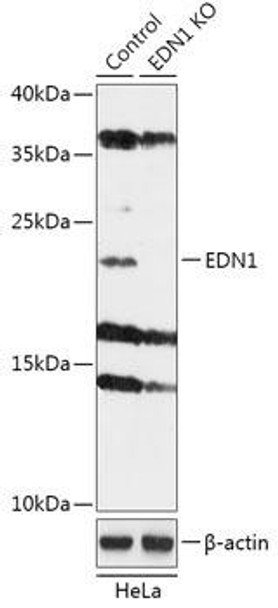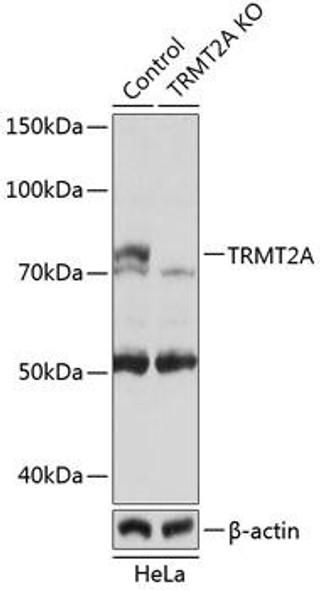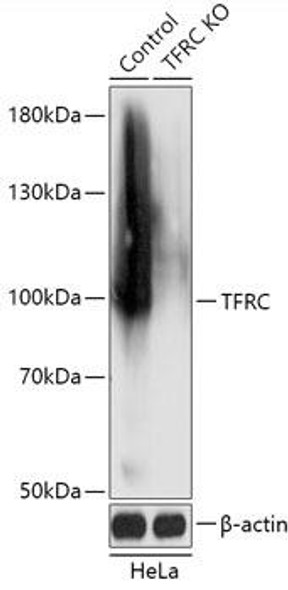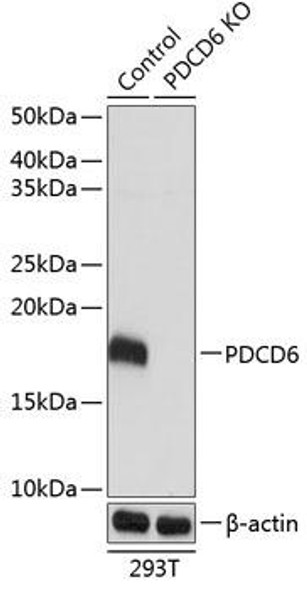Description
Anti-EDN1 Antibody (CAB18004)[KO Validated]
The KO-Validated EDN1 Rabbit Polyclonal Antibody (CAB18004) is a powerful tool for researchers studying Endothelin-1 (EDN1), a peptide involved in various physiological and pathological processes. This antibody, raised in rabbits, has been rigorously validated for use in knockout (KO) cell and tissue samples, ensuring accurate and reliable results in Western blot applications.Endothelin-1, a potent vasoconstrictor and mitogen, plays a key role in regulating blood pressure, vascular tone, and cell proliferation.
Dysregulation of EDN1 is associated with conditions such as hypertension, heart failure, and cancer, making it a compelling target for therapeutic intervention. The KO-Validated EDN1 Rabbit Polyclonal Antibody enables precise detection and analysis of EDN1 levels in cells and tissues, facilitating research in cardiovascular biology, oncology, and drug discovery.
| Antibody Name: | Anti-EDN1 Antibody [KO Validated] |
| Antibody SKU: | CAB18004 |
| Antibody Size: | 20uL, 50uL, 100uL |
| Application: | WB IHC IF |
| Reactivity: | Human, Mouse, Rat |
| Host Species: | Rabbit |
| Immunogen: | Recombinant fusion protein containing a sequence corresponding to amino acids 18-212 of human EDN1 (NP_001946.3). |
| Application: | WB IHC IF |
| Recommended Dilution: | WB 1:500 - 1:2000 IHC 1:50 - 1:100 IF 1:50 - 1:100 |
| Reactivity: | Human, Mouse, Rat |
| Positive Samples: | HeLa |
| Immunogen: | Recombinant fusion protein containing a sequence corresponding to amino acids 18-212 of human EDN1 (NP_001946.3). |
| Purification Method: | Affinity purification |
| Storage Buffer: | Store at -20°C. Avoid freeze / thaw cycles. Buffer: PBS with 0.02% sodium azide, 50% glycerol, pH7.3. |
| Isotype: | IgG |
| Sequence: | APET AVLG AELS AVGE NGGE KPTP SPPW RLRR SKRC SCSS LMDK ECVY FCHL DIIW VNTP EHVV PYGL GSPR SKRA LENL LPTK ATDR ENRC QCAS QKDK KCWN FCQA GKEL RAED IMEK DWNN HKKG KDCS KLGK KCIY QQLV RGRK IRRS SEEH LRQT RSET MRNS VKSS FHDP KLKG KPSR ERYV THNR AHW |
| Gene ID: | 1906 |
| Uniprot: | P05305 |
| Cellular Location: | Secreted |
| Calculated MW: | 24kDa |
| Observed MW: | 24kDa |
| Synonyms: | EDN1, ARCND3, ET1, HDLCQ7, PPET1, QME, endothelin-1 |
| Background: | This gene encodes a preproprotein that is proteolytically processed to generate a secreted peptide that belongs to the endothelin/sarafotoxin family. This peptide is a potent vasoconstrictor and its cognate receptors are therapeutic targets in the treatment of pulmonary arterial hypertension. Aberrant expression of this gene may promote tumorigenesis. Alternative splicing results in multiple transcript variants. |
| UniProt Protein Function: | EDN1: Endothelins are endothelium-derived vasoconstrictor peptides. Belongs to the endothelin/sarafotoxin family. |
| UniProt Protein Details: | Protein type:Secreted, signal peptide; Secreted Chromosomal Location of Human Ortholog: 6p24.1 Cellular Component: extracellular space; cytoplasm; extracellular region Molecular Function:protein binding; hormone activity; endothelin B receptor binding; cytokine activity; endothelin A receptor binding Biological Process: response to nicotine; positive regulation of JNK activity; elevation of cytosolic calcium ion concentration during G-protein signaling, coupled to IP3 second messenger (phospholipase C activating); positive regulation of nitric oxide biosynthetic process; regulation of systemic arterial blood pressure by endothelin; heart development; response to lipopolysaccharide; middle ear morphogenesis; prostaglandin biosynthetic process; sensory perception of pain; positive regulation of MAP kinase activity; negative regulation of cAMP biosynthetic process; elevation of cytosolic calcium ion concentration; cell surface receptor linked signal transduction; cell-cell signaling; negative regulation of nitric-oxide synthase biosynthetic process; protein kinase C activation; cell growth; neutrophil chemotaxis; rhythmic excitation; positive regulation of mitosis; negative regulation of blood coagulation; positive regulation of heart rate; respiratory gaseous exchange; response to testosterone stimulus; response to amino acid stimulus; peptide hormone secretion; leukocyte activation; patterning of blood vessels; membrane depolarization; protein kinase C deactivation; regulation of vasoconstriction; positive regulation of transcription from RNA polymerase II promoter; response to activity; superoxide release; positive regulation of odontogenesis; epithelial fluid transport; phosphoinositide 3-kinase cascade; G-protein signaling, phospholipase D activating pathway; neural crest cell development; positive regulation of cell size; negative regulation of hormone secretion; positive regulation of smooth muscle cell proliferation; negative regulation of cellular protein metabolic process; glucose transport; negative regulation of transcription from RNA polymerase II promoter; vein smooth muscle contraction; histamine secretion; nitric oxide transport; positive regulation of cell proliferation; regulation of pH; positive regulation of smooth muscle contraction; artery smooth muscle contraction; vasoconstriction; inositol phosphate-mediated signaling; in utero embryonic development; calcium-mediated signaling; positive regulation of hormone secretion; multicellular organismal aging; body fluid secretion; G-protein coupled receptor protein signaling pathway; dorsal/ventral pattern formation; cartilage development; response to ozone; positive regulation of prostaglandin secretion; maternal process involved in parturition; regulation of sensory perception of pain; positive regulation of cell migration Disease: Question Mark Ears, Isolated; Auriculocondylar Syndrome 3 |
| NCBI Summary: | The protein encoded by this gene is proteolytically processed to release a secreted peptide termed endothelin 1. This peptide is a potent vasoconstrictor and is produced by vascular endothelial cells. Endothelin 1 also can affect the central nervous system. Two transcript variants encoding different isoforms have been found for this gene. [provided by RefSeq, Nov 2009] |
| UniProt Code: | P05305 |
| NCBI GenInfo Identifier: | 119610 |
| NCBI Gene ID: | 1906 |
| NCBI Accession: | P05305.1 |
| UniProt Secondary Accession: | P05305,Q96DA1, |
| UniProt Related Accession: | P05305 |
| Molecular Weight: | 24,425 Da |
| NCBI Full Name: | Endothelin-1 |
| NCBI Synonym Full Names: | endothelin 1 |
| NCBI Official Symbol: | EDN1 |
| NCBI Official Synonym Symbols: | ET1; QME; PPET1; ARCND3; HDLCQ7 |
| NCBI Protein Information: | endothelin-1; preproendothelin-1 |
| UniProt Protein Name: | Endothelin-1 |
| UniProt Synonym Protein Names: | Preproendothelin-1; PPET1 |
| Protein Family: | Endothelin |
| UniProt Gene Name: | EDN1 |
| UniProt Entry Name: | EDN1_HUMAN |


![Anti-EDN1 Antibody [KO Validated] (CAB18004)](https://cdn11.bigcommerce.com/s-h68l9z2lnx/product_images/c/432/A18004_1__82938.jpg)







